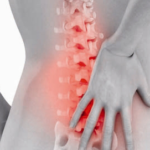How to deal with pain in the leg with a herniated spine
Many people know that a spinal hernia is not a simple disease that is often accompanied by a wide range of additional unpleasant symptoms. Pain in the leg with a hernia of the spine is one of these signs that can significantly reduce a person's quality of life.
Why does a herniated disc lead to problems with the lower extremities? Are there any effective means of dealing with unpleasant sensations? How to help yourself and, most importantly, whether the help of a doctor is needed.
Features of symptoms
Many patients are concerned about the question of how exactly the legs hurt with a hernia of the spine? Are there any specific features? Symptoms are mostly very specific, but their severity and some accents may vary from patient to patient. The differences are explained by the fact that the pathological protrusion can be localized in different parts of the spinal column and, accordingly, compress different parts of the nerve trunks.
The lower extremities in patients are most often affected if the vertebral defect is determined in the lumbar region. In this case, it can suffer, as only one limb, or both at once.
The following human complaints are considered characteristic:
- if the leg becomes numb, doctors may assume that the fact is that the hernia has pinched one or more sensory nerves;
- cramping of the limb is possible, especially if the patient had to spend a long time on his feet or walk for several hours;
- if there is a “lumbago” in the lower back or leg, a feeling that a current was let through the body when the body was turned, for example, then the fact is that one of the roots of the spinal cord is clamped by an intervertebral hernia;
- severe pain can develop due to the fact that swelling in the sciatic nerve irritates the nerve endings (the spread of pain is also possible in the thigh, lower back, and if most of the nerve swells, then the pain syndrome is so pronounced that the patient loses the ability to lean on the leg on the affected side)
- the patient pulls his leg with severe back pain, which indicates a pronounced pinching of the vertebral nerves, which must be stopped as soon as possible;
- many patients, turning to the doctor, complain that the leg dries up, i.e. not only pain is felt, but also the muscle tone in the affected area decreases, a significant part of the normal sensitivity disappears.
If the case is very severe, then numbness of the leg with a hernia of the spine over time can lead to loss of functionality of the limb. In parallel, the functions of internal organs can also be affected, which ultimately leads to disability.
What is the cause of pathology
Many people wonder why exactly the leg hurts with a hernia of the spine? What is the pathogenesis of the disease and how is the hernial protrusion associated with discomfort in the lower extremities?
If a hernial protrusion has been identified, all patient complaints usually develop according to two main mechanisms. Moreover, interestingly, the mechanism can act both jointly and separately for each individual patient.
In the first case, the protrusion compresses the nerve trunks that provide innervation to the lower extremities. In this case, the sensitive sphere mainly suffers, because of which the patient complains of a spasm, that the leg is cramping, pains appear in the limb, which attract the patient's attention. At the same time, the doctor may conclude that the pathology was severely neglected, since even symptoms appeared, indicating involvement in the processes of the lower extremities.
The second case is reflex. If the leg is in a reduced state for a long time, then after the situation is resolved, there is a feeling that it was pulled, sensitivity is disturbed, and swelling in the affected area is possible. It is believed that the second option rarely occurs in practice, and the main reason is mainly in the clamping of the nerve trunks.
Diagnostics
Weakness in the legs and other discomfort can be triggered not only by a hernia in the lumbar spine, but also by other diseases of the musculoskeletal system. In order to choose the right treatment, the patient must undergo a thorough diagnosis under the supervision of a doctor.
Diagnostics will help determine why the legs lose their functionality, and also give a hint on how to fix it.
Various diagnostic methods are used. The doctor first determines sensitivity using several approaches. For example, simply pressure, a sense of vibration, temperature sensitivity, and several other types of sensations can be determined, the presence or absence of which must be established to complete the picture.
Of the diagnostic techniques, radiography and CT are the most widely used. These methods allow you to establish whether there are any pathological displacements of the vertebrae, as well as to see the cause of these displacements. In addition to CT, in doubtful cases, MRI is additionally used.
Treatment approaches
What to do if there is pain in the leg with a hernia of the spine ? How to help yourself and is it possible to do it at home? If the diagnosis is not known exactly, it is imperative to visit a doctor to make sure that the patient has exactly the disease that he suspects. If the diagnosis is known, a visit to the doctor is still unavoidable, since it will be necessary to choose the most optimal treatment.
Manual therapy
One of the popular ways to relieve discomfort is manual therapy. At the head of this technique is the massage effect. It is most optimal to carry out exposures at a time when there is already a pronounced pain syndrome, but numbness and other unpleasant signs have not yet developed.
With the help of manual therapy, you can purposefully increase the tone of muscle elements, activate regenerative processes.
According to doctors, manual therapy has the following features that must be considered in order to successfully get rid of a hernia:
- massage should be trusted only to a specialist who is well acquainted with the anatomy of the human body and will not harm during his manipulations;
- the initial stage of the pathology can be completely eliminated with the help of manual intervention;
- for a visible effect, you will have to go through at least 15 sessions;
- during the session, actions should be directed to the muscles, and not to the bone structures;
- only relaxation of the muscles will help to achieve regression of the pathological protrusion.
Manual therapy is often used in combination with other techniques, as it is able to show its maximum effectiveness in this way.
Medicines
If anyone has ever had a leg pain due to hernial protrusions, he can well imagine what kind of panic covers a person at these moments. Especially strong fear is felt if the pain occurs suddenly, while the patient is in a public place away from the hospital or simply alone. It's so scary to lose mobility!
To stop the pathology on the spot, it is recommended to use various groups of medicines. It is important to keep in mind that the main task is not to eliminate numbness or pain, but to remove the inflammatory process. That is, medicines should act not on the symptoms, but on the cause.
Today, the following set of tools effectively relieves discomfort:
- Ketonal is a drug that has a good analgesic effect, but also eliminates the swelling of surrounding tissues. For seizures, it is used in an amount of 2 ml in the form of injections.
- Dicloberl - a remedy that has a strong anti-edematous effect, but practically does not relieve pain, eliminates inflammatory processes within 15-20 minutes, due to which there is a strong improvement in the general condition of the patient. It is also recommended to be injected.
- Torsid is a diuretic that is used to eliminate excess fluid from the body and relieve swelling. Injections are preferred.
The choice of medicines is best left to the doctor.
Surgery
Surgical treatment is another effective method of solving the problem, although doctors try their best to avoid it. Going under the surgeon's knife makes sense only if no conservative methods can get rid of the disease, and it only gradually progresses, affecting the patient's quality of life.
Today, there are many minimally invasive ways to solve the problem that can be used in order to improve the patient's condition. For example, laser treatment, microdiscectomy and other methods are used. However, if the hernial protrusion is severely neglected and large, you will have to resort to open surgery on the spinal column.
If a person has pain in the leg with a hernia of the spine, he needs to seek help from a doctor, and not try to self-treat. Hernia is a pathology that is much easier to cure at the earliest stages of its development, when the symptoms are not too acute, and the rhythm of a person’s life is not very pronounced.
It is much easier to cure a pathology when it has just formed than, having started the disease strongly, go to surgery, and then go through a long and unpleasant rehabilitation period, face complications that can develop after the intervention. Timely consultation with a specialist is a good way to protect yourself from loss of health with subsequent disability, which is inevitable if a hernia is ignored.










